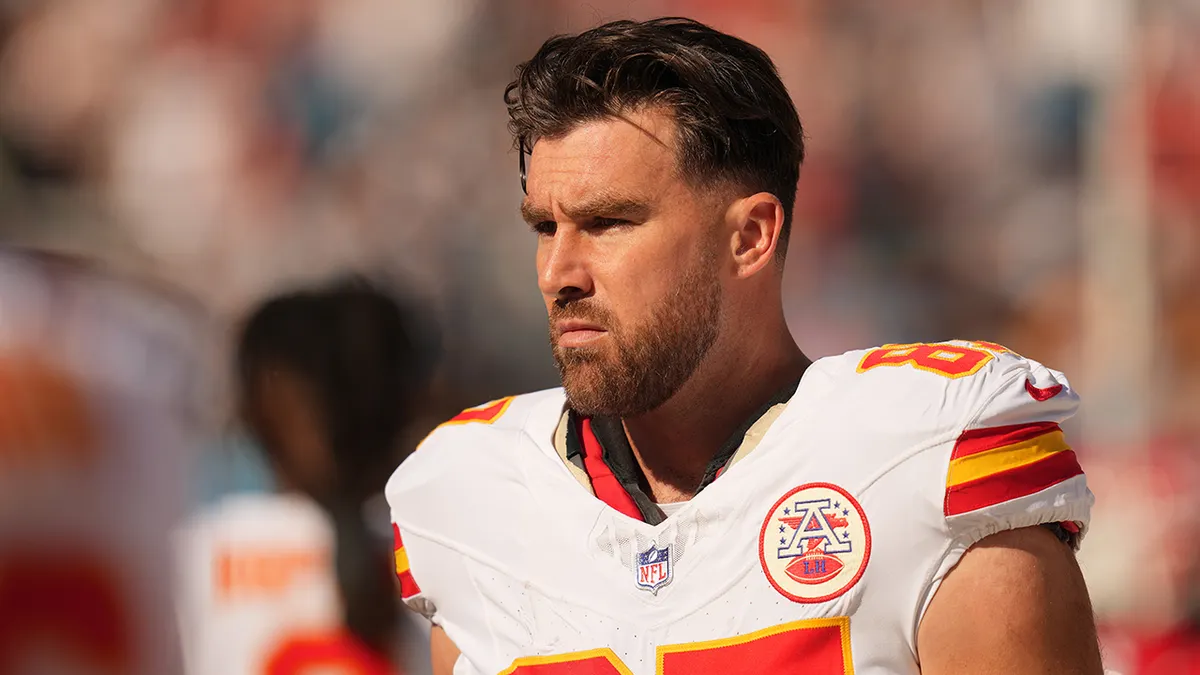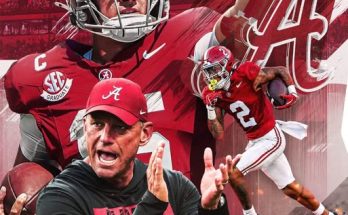The NFL’s debate surrounding the controversial “tush push” play continues to make headlines, with various teams, coaches, and players weighing in on whether it should remain a part of the game. The Philadelphia Eagles, led by quarterback Jalen Hurts, have become known for their highly successful execution of the play, which involves a quarterback sneak with the help of teammates pushing from behind. Its efficiency has sparked intense discussions on whether the NFL should take action to ban the play, arguing that it’s too effective and could lead to safety concerns.
Among the voices offering opinions on the subject is Kansas City Chiefs tight end Travis Kelce, who recently weighed in with a critical reminder as the debate rages on. Known for his on-field brilliance and candid personality, Kelce’s take on the matter provides a fascinating perspective from one of the league’s top players and highlights some of the underlying issues at the core of the conversation.
Kelce’s reminder, while coming from the perspective of a player who is not directly involved in the play’s execution, taps into the broader context of NFL play-calling and innovation. Let’s explore the points Kelce raised, the broader implications of the tush push debate, and why his perspective might resonate with both players and fans alike.
The Tush Push Debate: A Growing Controversy
At the heart of the tush push debate is its effectiveness and safety concerns. In short-yardage situations, such as third-and-1 or fourth-and-1, the play has become nearly unstoppable for the Philadelphia Eagles. With Jalen Hurts at quarterback, the Eagles line up in a formation that allows the offensive line, tight ends, and sometimes running backs to push Hurts forward, gaining just enough yardage to move the chains. This play has been instrumental in the Eagles’ offensive success, with Hurts himself being a key factor due to his strong lower body and ability to power through defenders.
While the tush push has been a successful strategy for the Eagles, it has raised several concerns. First, critics argue that the play is too effective, giving teams that use it a distinct advantage in short-yardage situations. The play is almost automatic, with a high conversion rate, and some feel that it detracts from the challenge and strategy involved in short-yardage scenarios.
Second, there are valid concerns about the safety of players, especially in a game that already features significant physical contact. The tush push requires a lot of pushing and shoving, and there is a fear that it could lead to injuries, particularly for quarterbacks who are already vulnerable during such high-intensity moments. With defenders trying to stop the play by creating a wall of resistance, the added force could lead to neck, back, or leg injuries, sparking debates on whether the play is too dangerous for players on both sides of the ball.
In response to this growing controversy, NFL executives have begun considering whether to ban the play entirely, with some coaches and players agreeing that it needs to be eliminated from the game. However, others feel that the tush push is a legal strategy and a clever use of existing rules, which leads to interesting debates about player safety, fairness, and innovation in the game.
Travis Kelce’s Reminder: A Different Perspective
As the debate unfolds, Travis Kelce, a key figure in the Kansas City Chiefs’ offensive scheme and one of the NFL’s most celebrated tight ends, took to the media to weigh in. While Kelce himself is not known for executing the tush push—a play that’s primarily associated with the Eagles’ quarterback sneak offense—he still found it important to issue a reminder in the midst of the debate.
Kelce’s perspective centers on a critical point: innovation and strategy are part of what makes the NFL exciting. Kelce argued that instead of trying to eliminate or limit new plays and strategies like the tush push, the league should embrace the fact that teams are constantly looking for ways to gain an advantage. He reminded fans and critics alike that the NFL has always been a league driven by innovation, and that’s what keeps it fresh and entertaining.
The Importance of Evolution in the NFL
Kelce pointed out that throughout the history of the NFL, innovative plays have continually emerged and changed the way the game is played. The Wildcat offense, run-pass options (RPOs), and no-huddle offenses are just a few examples of strategies that once sparked controversy but eventually became integral parts of the league. Quarterback sneaks, which the tush push is derived from, have been part of the game for decades, and now a new variation of it is proving successful for a particular team.
By embracing innovation, Kelce suggests, the league stays dynamic. Teams are always seeking new ways to exploit weaknesses in the defense or gain an edge in key situations. Kelce emphasized that it’s the nature of the game for coaches, players, and organizations to push the envelope and find creative solutions to problems. In this case, the Eagles’ ability to master the tush push is an example of innovation, not something that should be banned because of its effectiveness.
Player Safety Concerns and the Physical Nature of Football
Kelce did acknowledge the player safety concerns associated with the play. Football, after all, is an inherently physical sport, and there’s always the possibility of injury in any play, particularly in short-yardage situations. However, he pointed out that player safety has always been a concern in the NFL and that teams and players must constantly adjust to evolving safety standards. Kelce mentioned that the NFL has taken significant steps over the years to protect players, especially when it comes to concussions and contact to the head.
Kelce’s reminder here was subtle yet powerful: injuries are a part of the game, but the league’s efforts to safeguard its athletes are ongoing. He suggested that rather than eliminating effective plays like the tush push, the NFL should focus on better regulating the physical aspects of the game, such as blocking techniques or training methods that could help prevent injuries during plays like the tush push.
The Evolving Role of the Quarterback
One of the more interesting aspects of the tush push is the role of the quarterback, particularly Hurts, in executing the play. As Kelce noted, Jalen Hurts is built like a running back and has the physicality and mentality to succeed in short-yardage situations. For Hurts, the tush push allows him to leverage his strength and ability to drive forward, rather than just relying on his arm to make plays.
In this sense, Kelce’s reminder also touched on the evolving role of quarterbacks in today’s NFL. No longer just pocket passers, quarterbacks like Hurts, Patrick Mahomes, and Josh Allen are now expected to be dual threats capable of both passing and running the ball effectively. The ability to execute short-yardage plays like the tush push highlights the changing nature of quarterback play, and Kelce believes this is part of the NFL’s natural evolution.
He expressed that it’s refreshing to see quarterbacks becoming more than just traditional pocket passers. By incorporating powerful short-yardage plays into their repertoire, quarterbacks are able to diversify their skill sets and help their teams gain crucial advantages.
Kelce’s Final Take: Embracing the Challenge
In the end, Travis Kelce’s reminder was a call to embrace the challenge of defending against innovative plays, rather than trying to ban them outright. He believes the NFL should continue to encourage strategic evolution, where teams are allowed to develop new ways of winning, as long as they follow the rules of the game.
Kelce acknowledged that the tush push has certainly created a dilemma for defenses, but he also pointed out that it’s up to opposing teams to adapt and find ways to stop it. After all, the game of football has always been about adjustments. As Kelce puts it, if one team has found success with a particular strategy, it’s the responsibility of the other teams to study the play and come up with ways to counter it.
His point about innovation and strategy serves as a reminder that the NFL is constantly evolving. Whether it’s the introduction of new technologies, better training techniques, or new plays like the tush push, the league’s ongoing growth and adapting to the times are key to maintaining its place as the most popular sport in the United States.



